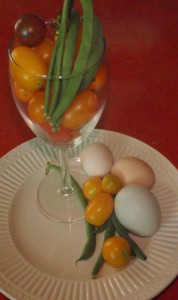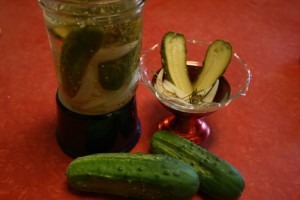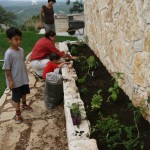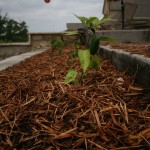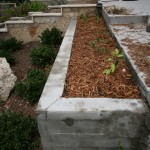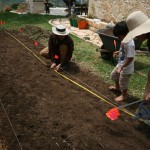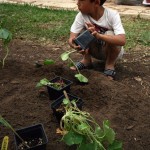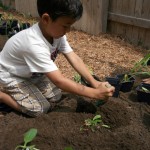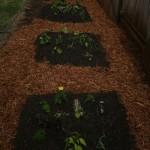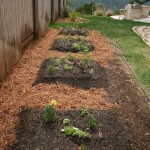Hello from the Bohemian Bounty crew. Many of you are beginning to enjoy the fruits of your garden labor – literally! It’s harvest time! So, we’ve put together a quick reference for the most common items you may be growing this season. You don’t have to read this top to bottom. Just refer to it when you need it!
As always, feel free to send us any questions you have!
Jennifer and James Buratti
PS – We plant to offer a Canning 101 class in the next few weeks. You can make your own pickles, relishes, jams and jellies! We’ll send more info shortly.
Beans – (Green, Pole, Bush, Climbing, French, etc) – Beans are very productive and once they begin to produce you may need to harvest them daily! You can pick bean pods at any size, but most often they are picked before the bean begins to fully develop in the pod. Sizes can range from 3 to 8 inches in length. You can also let bean pods mature and shell them. Be careful when harvesting beans to snap the pods off just above the stem. If you yank at the bean you can break the stalk taking flowers and immature beans with it. Make sure to remove older mature pods you may have overlooked as leaving these on will decrease productivity.
Storage: If they aren’t going to be cooked right away, store beans in a perforated plastic bag in your refrigerator veggie compartment. Use them within a week while they are fresh. Do not wash bean pods until you are ready to cook them. Storing wet beans will cause them to go bad quickly. Beans can also be frozen but need to be blanched first to destroy enzymes that cause color and flavor loss. Bean pods can also be pickled with dill, garlic and cayenne pepper – a personal favorite! Learn about this one in our canning workshop.
Cooking: There are a variety of ways to cook fresh beans but the simplest is to bring a small amount of water to boil. Snap or cut off the stem end and cook whole or in smaller pieces. Cook uncovered for the first few minutes then cover and cook until just crisp, about 13 to 15 minutes for a pound of beans. Flavor with fresh basil, dill, marjoram, mint, oregano or thyme from your garden.
Nutrition: From The World’s Healthiest Foods http://whfoods.org/genpage.php?tname=foodspice&dbid=134
Green beans, while quite low in calories (just 43.75 calories in a whole cup), are loaded with enough nutrients to not only power up the Jolly Green Giant, but to put a big smile on his face. Green beans are an excellent source of vitamin C, vitamin K and manganese. Plus green beans are very good source of vitamin A (notably through their concentration of carotenoids including beta-carotene), dietary fiber, potassium, folate, and iron. And, green beans are a good source of magnesium, thiamin, riboflavin, copper, calcium, phosphorus, protein, omega-3 fatty acids and niacin
Cucumbers: Once they start to bear fruit, cucumbers, like beans, can be very productive. Vines produce for 4 to 6 weeks and fruit should be picked before they get too large. Large cucumbers will have tougher, bitter skins and large inedible seeds. They will also decrease production if you let them get big. Inspect your vines closely as cucumbers have a way of hiding within their big fuzzy leaves. Cutting fruit off with scissors or a knife helps avoid damaging the vine.
Storage: Cucumbers can be stored in plastic bags in your refrigerator for up to 10 days, but will loose their crispness the longer you store them. Cucumbers do not freeze well but can be pickled in a variety of ways. Bohemian Bounty will hold a canning and storage clinic this summer. Come learn to pickle with us!
Cooking: Cucumbers are most often eaten raw in salads in the US but there are a number of ways to enjoy them. Cucumber sandwiches are a popular British import. Serving cubed cucumber with dill is common but other herbs work well including mint, cilantro, basil, thyme, and rosemary. You can even bake them!
Nutrition: From The World’s Healthiest Foods http://whfoods.org/genpage.php?tname=foodspice&dbid=42
Trying to get adequate dietary fiber on a daily basis is a challenge for many Americans. Adding a crunchy cool cucumber to your salads is an especially good way to increase your fiber intake because cucumber comes naturally prepackaged with the extra fluid you need when consuming more fiber. Plus, you get the added bonus of vitamin C, silica, potassium and magnesium.
Eggplant (Purple, Chinese, Thai, Black Beauty, Ichiban, White, etc): More variety of eggplant are available than even before! Eggplant take about 3 weeks to fully mature, although they can be harvested earlier. Harvest eggplant while they still have a glossy color to them, be they purple, green or white. Once dull they will be bitter and have large, inedible seeds. The fruit’s stems can be very tough and even a bit thorny so use a good pair of garden or kitchen scissors to remove them.
Storage: Eggplants can be stored for about 7 to 10 days at 50-55 degrees. Fresh eggplant can be sliced, blanched and frozen for later use.
Cooking: Eggplant can be baked, roasted in the oven, sautéed or steamed. To tenderize an eggplant, sprinkle slices with salt and let it rest for 30 minutes. Rinse off the salt with water before preparing.
Nutrition: From from The World’s Healthiest Foods http://www.whfoods.com/genpage.php?tname=foodspice&dbid=22
Eggplant is a very good source of dietary fiber, potassium, manganese, copper and thiamin (vitamin B1). It is also a good source of vitamin B6, folate, magnesium and niacin. Eggplant also contains phytonutrients such as nasunin and chlorogenic acid.
Herbs (Basil, Milt, Cilantro, Sage, Thyme, Catnip, Dill, Oregano, Rosemary, etc): Herbs, once established in your garden, are a hardy bunch. They can be harvested again and again when you need them, or dried for later use. Most herbs you can simply pluck off the leaves as you need them. Be sure to take leaves from throughout the plant as to distribute the impact. When you need a large quantity you can harvest an entire stem. If you let dill go to flower you can harvest the seed heads. Most herbs should not be allowed to go to flower as this will decrease their productivity. Just pinch off the flowers when you see them.
Storage: We recommend harvesting leaves as you need them. Drying is the most common way to store herbs and can be done by clipping a bundle of stems or the entire plant and hanging it to dry. Remove any dead or diseased leaves before bundling 5 to 7 branches together and tying with a string. Placing them in a paper bag helps them retain their color and the bag will retain any leaves that drop. However, this is not required and a little more work. You would then tie the bag off and hang them to dry in a low humidity room. You can even hang them in the refrigerator if you have the room. If you forego the bag, hang the entire plant up to dry. After drying, strip the leaves and store them in air-tight containers.
Okra: Okra pods mature very quickly and plants should be picked daily. Pods are best at 2 to 4 inches long, though some varieties are bred to be much shorter and plump. Large okra are stringy and and tough. Always remove large okra so the plant will continue to be productive. Harvest okra pods with pruning shears as the stem can be quite tough. Some people experience an itchy rash when coming in contact with okra leaves. iIf this happens to you, be sure to wear long sleeves and gloves to gather the okra pods.
Storage: Okra deteriorates rapidly after harvest but can be stored about a week at 45 to 50 degrees. Many recommend storing them in a paper bag in the warmest part of your refrigerator. Do not wash them prior to storage. Pickled okra with dill and cayenne pepper is a favorite Texas summer treat.
Cooking: Okra is delicious fried but can also be steamed, stewed, baked, eaten raw or my favorite – pickled!
Nutrition: From The University of Illinois Extension http://urbanext.illinois.edu/veggies/okra1.html#9
Okra is a powerhouse of valuable nutrients. Nearly half of which is soluble fiber in the form of gums and pectins. Soluble fiber helps to lower serum cholesterol, reducing the risk of heart disease. The other half is insoluble fiber which helps to keep the intestinal tract healthy decreasing the risk of some forms of cancer, especially colorectal cancer. Nearly 10% of the recommended levels of vitamin B6 and folic acid are also present in a half cup of cooked okra.
Peas: Like beans, peas can be prolific and there are many varieties. Snap, sugar and snow peas are winter varieties that have probably already finished their spring run. These are harvested before the individual peas are mature and the entire pea pod is eaten, either raw or cooked. Shelling peas are harvested after the peas have matured, or slightly before, and the pods will look full, puffy and green. The size of the pods will depend upon the variety, anywhere from a few inches to more than foot! Be careful picking the pea pods as to not damage the mother plant by pulling off stems, leaves and other immature peas and flowers.
Storage: Unshelled peas can be stored in the refrigerator in a plastic bag up to a week. You can also shell or “hull” peas before storage. To hull peas snap off the bottom of the pea pod. Some varieties will have a handy string that loosens one side of the pod. Some beans work this way as well. If they do not have a string gently cut them open with a knife and remove the peas. Hulled peas do not store for a long period of time so you’ll want to use them within a few days. For long term storage quickly blanch the hulled peas and store in plastic freezer bags in the deep freeze for up to 9 months.
Cooking: Cooked peas can be added to just about any dish from salads to stir fries or they are great on their own. They are traditionally steamed or boiled for 12 to 20 minutes. Add you favorite herbs from the garden and spices.
Nutrition: From The World’s Healthiest Foods http://www.whfoods.com/genpage.php?tname=foodspice&dbid=55
Green peas are a very good source of vitamin C, vitamin K, manganese, dietary fiber, folate and thiamin (vitamin B1). They are also a good source of vitamin A, phosphorus, vitamin B6, protein, niacin, magnesium, riboflavin (vitamin B2), copper, iron, zinc and potassium.
Peppers (bell, sweet, hot, banana, jalapeño, serrano, etc) : Bell peppers can be harvested at any size, but most often you can wait until they are 3 to 4 inches long. Colored varieties are best when their color has fully developed red, yellow, orange, brown or purple. The stems of ripe bells will break off the plant easily but cutting them will assure no accidental damage to the plant.
Hot peppers, like bells can be harvested at any time. Many hot peppers will turn red at full maturity. Handle them with care at harvest or you can get a nasty surprise when you touch your face and eyes.
Storage: Peppers can be stored in the vegetable drawer in your fridge for up to a week. If you have more than you can use, consider freezing them. Bells and other large, fleshy peppers can be washed, cored then cut in strips. Place the strips one a single layer in a cookie sheet and freeze them. Once frozen, transfer then to a freezer bag. This makes using them a little at a time much easier. Smaller hot peppers can be frozen whole or air-dried in a food drier.
Cooking: Peppers can be enjoyed raw, sautéed, grilled, baked or even pickled. Pickled jalapeños are a Texas favorite.
Nutrition: From The World’s Healthiest Foods http://whfoods.org/genpage.php?tname=foodspice&dbid=50
One cup of raw, chopped red peppers provides over 100% of the DV for vitamin C and vitamin A. Red peppers are also an excellent source of vitamin B6. Green peppers are a very good source of fiber, folate, and vitamin K as well as the minerals molybdenum and manganese. In addition to beta-carotene, red peppers contain the beneficial phytonutrients lycopene, lutein and zeaxanthin.
Potatoes: Harvesting potatoes is like searching for buried treasure – you never know what the bounty will be until you dig them up! Potatoes are ready to harvest once the top part of the plant begins to die back. Potatoes left in the ground for at least a week after the plant has been dead will store longer. Make sure to stop watering your plants a week before you intend to dig them. This will harden the tuber and make harvesting easier. Be careful not to stab your potatoes with your pitch fork as you harvest them. Lift from the side and be sure to dig deep. You don’t want to miss any. This one is great to do with the kids!
Storage: Potatoes can be eaten fresh or can be “cured” (made ready for storage) by placing them in burlap sacks or on dry, crumpled newspaper were they will get some airflow and be out of direct sunlight and rain, preferable below 70 degrees. Do not store them in plastic bags! Curing can last one to two weeks. Do not wash them until after they are cured. They can then be stored at 45 degrees until eaten. Higher temperatures will make them break dormancy and sprout while exposure to light will cause potatoes to turn green. When preparing potatoes, green areas should be cut away and discarded. Rotting tubers should be discarded quickly, as well. Potatoes will keep about 2 months.
Cooking: You don’t have to fry them! Potatoes can be baked, boiled, steamed, mashed or roasted. Your family probably has its favorite recipe and fresh potatoes from your own garden will transform it!
Nutrition: From The World’s Healthiest Foods http://www.whfoods.com/genpage.php?tname=foodspice&dbid=48
Potatoes are a very good source of vitamin C. They are also a good source of vitamin B6, copper, potassium, manganese, and dietary fiber. Take away the extra fat… from butter, sour cream, melted cheese and bacon bits… and deep frying, and a baked potato is an exceptionally healthful low calorie, high fiber food that offers significant protection against cardiovascular disease and cancer.
Summer Squash (yellow, crookneck, straightneck, patty pan, scallop, zucchini, calabaza, etc): There are a wide variety of summer squash and all of them are tasty! Squash flowers, skin, flesh and seeds are all edible. They mature very quickly and should be picked when fruits are young and tender. For the elongated variety this means less than 2 inches in diameter and less than 7 inches long. For the scalloped variety harvest when they are 3 to 4 inches across. Older, larger squash should be picked so the plant can put that energy into the younger squash. Larger squash with large seeds can be used by scooping out the seeds, filling the squash and baking.
Storage: Summer squash should be stored unwashed in a plastic bad or a high humidity food crisper drawer. Squash will keep up to a week but rot quickly once they are damaged or too moist. Squash can also be frozen for later use, though it is recommended slicing and blanching them first.
Cooking: Summer squash can be sautéed, baked, steamed, or eaten raw. Slicing them thin, skin on, and cooking in a skillet with olive oil, onion and fresh herbs from the garden is a quick and easy summer side dish.
Nutrition: From The World’s Healthiest Foods http://whfoods.org/genpage.php?tname=foodspice&dbid=62
Summer squash is an excellent source of manganese and vitamin C. It is also a very good source of magnesium, vitamin A, dietary fiber, potassium, copper, folate, and phosphorus. In addition, summer squash is a good source of omega-3 fatty acids, vitamin B1, vitamin B2, vitamin B6, calcium, zinc, niacin, and protein.
Swiss Chard: Swiss chard leaves can be harvested at any size, both small or large. Harvest a few leaves at a time by cutting them off near the base fora continuos supply throughout the growing season. Make sure to harvest the outer leaves leaving the smaller inner leaves to mature. Individual plants can actually last more than a year!
Storage: Leaves can be stored unwashed in the refrigerator for up to two weeks in a plastic bag in the food crisper drawer. They can also be chopped and frozen for later use.
Cooking: Smaller leaves can be eaten raw while larger leaves and their stems can be sautéed. Some of the varieties we’ve planted can produce leaves up to 2 feet long! I like to use a little olive oil, sea salt and oregano on mine. Yum! Chards have risen to the top of the Bohemians list a favorite, easy-to-grow, easy-to-cook, healthy vegetable from the garden. Popeye would do well to ditch the spinach for chards.
Nutrition: From The World’s Healthiest Foods http://whfoods.org/genpage.php?tname=foodspice&dbid=16
Swiss chard is an excellent source of vitamin K, vitamin A, vitamin C, magnesium, manganese, potassium, iron, vitamin E and dietary fiber. It is a very good source of copper, calcium, vitamin B2, vitamin B6 and protein. In addition, Swiss chard is a good source of phosphorus, vitamin B1, zinc, folate, biotin, niacin and pantothenic acid.
Tomatoes: Be they red, purple, yellow or striped, small or soft-ball sized, tomatoes mean summer gardens. Pick tomatoes when they are mostly uniform in their final color. I’d say uniformly red, but lots of tomatoes aren’t red these days! The fruit should be firm but give when you apply pressure, smooth and waxy in appearance. Some birds and squirrels may figure out red means ripe and start eating your tomatoes before you do. If so, you can pick them early and set them in a sunny spot indoors, cover the plant with netting or cover the tomatoes on the vine with pantyhose.
Storage: Store ripe tomatoes at room temperature for the best flavor. Temperatures below 54 degrees causes flavor and color to deteriorate. Store away from direct sunlight as light and heat will hasten ripening and eventually decay. They can also be canned, frozen or dried.
Cooking: Tomatoes can be enjoyed raw, sautéed, grilled, and stewed.
Nutrition: From The World’s Healthiest Foods http://whfoods.org/genpage.php?tname=foodspice&dbid=44
Tomatoes are an excellent source of vitamin C, vitamin A, and vitamin K. They are also a very good source of molybdenum, potassium, manganese, dietary fiber, chromium, and vitamin B1. In addition, tomatoes are a good source of vitamin B6, folate, copper, niacin, vitamin B2, magnesium, iron, pantothenic acid, phosphorus, vitamin E and protein.
Happy Harvesting!
Bohemian Bounty, LLC
Phone 512.757.4422
Fax 512.749.1563
http://www.BohemianBounty.com
Farm fresh vegetables…
…Picked at home.
